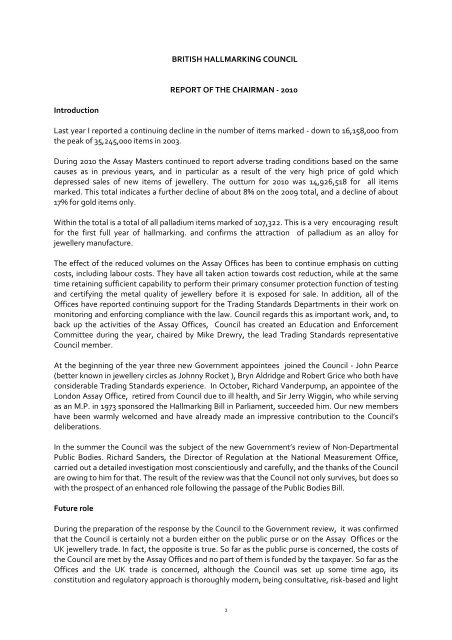Full Text (PDF) - Official Documents
Full Text (PDF) - Official Documents
Full Text (PDF) - Official Documents
Create successful ePaper yourself
Turn your PDF publications into a flip-book with our unique Google optimized e-Paper software.
Introduction<br />
BRITISH HALLMARKING COUNCIL<br />
REPORT OF THE CHAIRMAN ‐ 2010<br />
Last year I reported a continuing decline in the number of items marked ‐ down to 16,158,000 from<br />
the peak of 35,245,000 items in 2003.<br />
During 2010 the Assay Masters continued to report adverse trading conditions based on the same<br />
causes as in previous years, and in particular as a result of the very high price of gold which<br />
depressed sales of new items of jewellery. The outturn for 2010 was 14,926,518 for all items<br />
marked. This total indicates a further decline of about 8% on the 2009 total, and a decline of about<br />
17% for gold items only.<br />
Within the total is a total of all palladium items marked of 107,322. This is a very encouraging result<br />
for the first full year of hallmarking. and confirms the attraction of palladium as an alloy for<br />
jewellery manufacture.<br />
The effect of the reduced volumes on the Assay Offices has been to continue emphasis on cutting<br />
costs, including labour costs. They have all taken action towards cost reduction, while at the same<br />
time retaining sufficient capability to perform their primary consumer protection function of testing<br />
and certifying the metal quality of jewellery before it is exposed for sale. In addition, all of the<br />
Offices have reported continuing support for the Trading Standards Departments in their work on<br />
monitoring and enforcing compliance with the law. Council regards this as important work, and, to<br />
back up the activities of the Assay Offices, Council has created an Education and Enforcement<br />
Committee during the year, chaired by Mike Drewry, the lead Trading Standards representative<br />
Council member.<br />
At the beginning of the year three new Government appointees joined the Council ‐ John Pearce<br />
(better known in jewellery circles as Johnny Rocket ), Bryn Aldridge and Robert Grice who both have<br />
considerable Trading Standards experience. In October, Richard Vanderpump, an appointee of the<br />
London Assay Office, retired from Council due to ill health, and Sir Jerry Wiggin, who while serving<br />
as an M.P. in 1973 sponsored the Hallmarking Bill in Parliament, succeeded him. Our new members<br />
have been warmly welcomed and have already made an impressive contribution to the Council’s<br />
deliberations.<br />
In the summer the Council was the subject of the new Government’s review of Non‐Departmental<br />
Public Bodies. Richard Sanders, the Director of Regulation at the National Measurement Office,<br />
carried out a detailed investigation most conscientiously and carefully, and the thanks of the Council<br />
are owing to him for that. The result of the review was that the Council not only survives, but does so<br />
with the prospect of an enhanced role following the passage of the Public Bodies Bill.<br />
Future role<br />
During the preparation of the response by the Council to the Government review, it was confirmed<br />
that the Council is certainly not a burden either on the public purse or on the Assay Offices or the<br />
UK jewellery trade. In fact, the opposite is true. So far as the public purse is concerned, the costs of<br />
the Council are met by the Assay Offices and no part of them is funded by the taxpayer. So far as the<br />
Offices and the UK trade is concerned, although the Council was set up some time ago, its<br />
constitution and regulatory approach is thoroughly modern, being consultative, risk‐based and light<br />
1
















